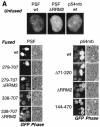PSF acts through the human immunodeficiency virus type 1 mRNA instability elements to regulate virus expression
- PMID: 12944487
- PMCID: PMC193712
- DOI: 10.1128/MCB.23.18.6618-6630.2003
PSF acts through the human immunodeficiency virus type 1 mRNA instability elements to regulate virus expression
Abstract
Human immunodeficiency virus type 1 (HIV) gag/pol and env mRNAs contain cis-acting regulatory elements (INS) that impair stability, nucleocytoplasmic transport, and translation by unknown mechanisms. This downregulation can be counteracted by the viral Rev protein, resulting in efficient export and expression of these mRNAs. Here, we show that the INS region in HIV-1 gag mRNA is a high-affinity ligand of p54nrb/PSF, a heterodimeric transcription/splicing factor. Both subunits bound INS RNA in vitro with similar affinity and specificity. Using an INS-containing subgenomic gag mRNA, we show that it specifically associated with p54nrb in vivo and that PSF inhibited its expression, acting via INS. Studying the authentic HIV-1 mRNAs produced from an infectious molecular clone, we found that PSF affected specifically the INS-containing, Rev-dependent transcripts encoding Gag-Pol and Env. Both subunits contained nuclear export and nuclear retention signals, whereas p54nrb was continuously exported from the nucleus and associated with INS-containing mRNA in the cytoplasm, suggesting its additional role at late steps of mRNA metabolism. Thus, p54nrb and PSF have properties of key factors mediating INS function and likely define a novel mRNA regulatory pathway that is hijacked by HIV-1.
Figures









Similar articles
-
Synergistic stimulation of HIV-1 rev-dependent export of unspliced mRNA to the cytoplasm by hnRNP A1.J Mol Biol. 1999 Feb 5;285(5):1951-64. doi: 10.1006/jmbi.1998.2473. J Mol Biol. 1999. PMID: 9925777
-
Interactions of INS (CRS) elements and the splicing machinery regulate the production of Rev-responsive mRNAs.J Mol Biol. 1996 Mar 29;257(2):246-64. doi: 10.1006/jmbi.1996.0160. J Mol Biol. 1996. PMID: 8609621
-
HIV-1 pre-mRNA commitment to Rev mediated export through PSF and Matrin 3.Virology. 2013 Jan 20;435(2):329-40. doi: 10.1016/j.virol.2012.10.032. Epub 2012 Nov 13. Virology. 2013. PMID: 23158102
-
A role for Rev in the association of HIV-1 gag mRNA with cytoskeletal beta-actin and viral protein expression.Biochimie. 1996;78(11-12):1075-80. doi: 10.1016/s0300-9084(97)86732-6. Biochimie. 1996. PMID: 9150887 Review.
-
Rev-dependent expression of three species of HIV-1 mRNAs (review).Int J Mol Med. 1999 Mar;3(3):297-302. doi: 10.3892/ijmm.3.3.297. Int J Mol Med. 1999. PMID: 10028055 Review.
Cited by
-
Inadvertent Transfer of Murine VL30 Retrotransposons to CAR-T Cells.Adv Cell Gene Ther. 2022;2022:6435077. doi: 10.1155/2022/6435077. Epub 2022 May 31. Adv Cell Gene Ther. 2022. PMID: 36081760 Free PMC article.
-
An Evaluation on the Role of Non-Coding RNA in HIV Transcription and Latency: A Review.HIV AIDS (Auckl). 2023 Mar 14;15:115-134. doi: 10.2147/HIV.S383347. eCollection 2023. HIV AIDS (Auckl). 2023. PMID: 36942082 Free PMC article. Review.
-
Refinement of lentiviral vector for improved RNA processing and reduced rates of self inactivation repair.BMC Biotechnol. 2009 Oct 7;9:86. doi: 10.1186/1472-6750-9-86. BMC Biotechnol. 2009. PMID: 19811661 Free PMC article.
-
Matrin 3 is a co-factor for HIV-1 Rev in regulating post-transcriptional viral gene expression.Retrovirology. 2011 Jul 20;8:61. doi: 10.1186/1742-4690-8-61. Retrovirology. 2011. PMID: 21771347 Free PMC article.
-
The splicing factor proline-glutamine rich (SFPQ/PSF) is involved in influenza virus transcription.PLoS Pathog. 2011 Nov;7(11):e1002397. doi: 10.1371/journal.ppat.1002397. Epub 2011 Nov 17. PLoS Pathog. 2011. PMID: 22114566 Free PMC article.
References
-
- Afonina, E., M. Neumann, and G. N. Pavlakis. 1997. Preferential binding of poly(A)-binding protein 1 to an inhibitory RNA element in the human immunodeficiency virus type 1 gag mRNA. J. Biol. Chem. 272:2307-2311. - PubMed
-
- Afonina, E., R. Stauber, and G. N. Pavlakis. 1998. The human poly(A)-binding protein 1 shuttles between the nucleus and the cytoplasm. J. Biol. Chem. 273:13015-13021. - PubMed
-
- Andersen, J. S., C. E. Lyon, A. H. Fox, A. K. Leung, Y. W. Lam, H. Steen, M. Mann, and A. I. Lamond. 2002. Directed proteomic analysis of the human nucleolus. Curr. Biol. 12:1-11. - PubMed
-
- Arrigo, S. J., and I. S. Y. Chen. 1991. Rev is necessary for translation but not cytoplasmic accumulation of HIV-1 vif, vpr, and env/vpu 2 RNAs. Genes Dev. 5:808-819. - PubMed
Publication types
MeSH terms
Substances
Grants and funding
LinkOut - more resources
Full Text Sources
